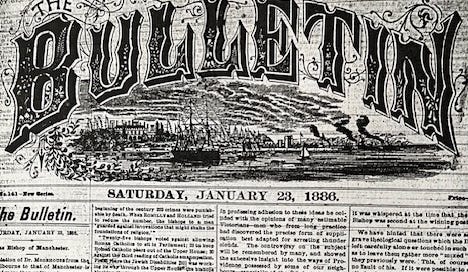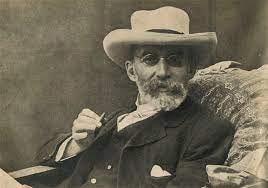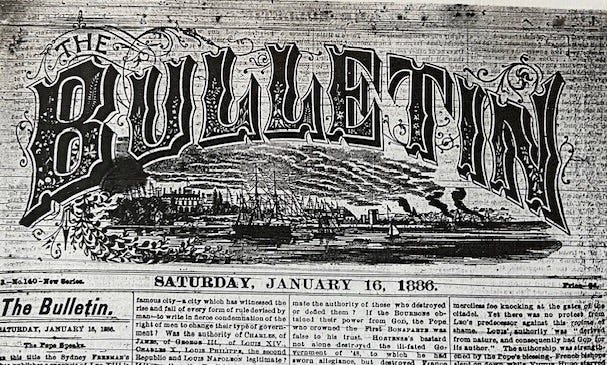A carnival of mockery: criticising Christianity in 19th Century Australia
From 1880 to the close of the 19th Century the Sydney Bulletin newspaper lampooned, lambasted and ridiculed the Christian churches and their ministers ... and its circulation soared.
By DAVID MYTON
Today public criticism of Christianity and its various denominations is commonplace. There are channels on YouTube, for example, which regularly critique the Christian faith. But it's really no big deal in open societies - those mocked can employ the same media to mock back or refute arguments if they so wish.
It was a bit different in the 19th century which was, says the scholar Professor Richard Evans, “beyond doubt a religious age”. To be sure, times were changing with the rise of new ideas and theories such as Darwinism, Marxism, of science and rationalism, but fully secularised society was a long way off.
But none of that stopped the Sydney Bulletin newspaper, which, between 1880-1901, constantly lampooned, lambasted and excoriated Christianity in all its guises.
Although circulating in an ostensible deeply religious society – in 1891, for example, 96 per cent of the population of New South Wales identified as Christian, and census records reveal little evidence of a general decline in religion or of a mass defection from Christianity - sales of the paper soared.
Under the editorship of J F Archibald, it was one of the most popular newspapers in the land and was read in both city and country by rich and by poor.
Archibald’s Bulletin didn’t think much of God, be He the God of the Christians or the God of anyone else.
Let’s look at some examples. In October 1887 there appeared a 2000 word article that typified the Bulletin’s attitude to religious hypocrisy. The commentary was inspired by the opening of the Magdalene Refuge for “fallen women” by the Catholic Archbishop of Sydney, Cardinal Patrick Moran.
The article gave a short history of prostitution then asserted that the “degradation of women” began thousands of years ago “in the East” which was a hotbed of “religious fanaticism” … “Whatever civilization has grown in the East has ended in the degradation of women …”[1]
In contrast, continued the writer, the mythology and early poetry of “our own Teutonic stock” bore the “unmistakable evidence of the dignity and equality of women with men”. The power and dignity of British women, for instance, could be seen in the Briton queen Boadicea.
The degradation of British women occurred under Christianity – an “Eastern religion” – but only slowly because, it says, Christianity was more influenced by the New Testament than by the Old, and by the teaching of Jesus “who was a socialist and universal man” rather than Moses, who was an “Eastern” and a believer in the priest-caste.
However, after the Reformation things changed because the Puritans aligned themselves with the Old Testament and “on nothing did these fanatics pour out the vials of their wrath, temporal and spiritual, their punishments and disgrace … than on the sins of the flesh. Then first this hateful phrase of ‘fallen women’ arose … Then the degradation of women, as a principle and a system began.[2]
Since then, society “dominated by the noisy dogmatism of the religious fanatics” had, for close on 300 years “… Been doing its best to make desperate every ‘unchaste’ girl, to turn her into a professional prostitute, and then to beat her down and keep her in the gutter, and keep her there …”[3]
Every form of “religious infatuation” and every “rabid ascetic” was responsible for the “damnable” misery of women.
The writer condemned Cardinal Moran for talking “antediluvian rot” in saying that prostitutes were ensnared by the “intoxication of guilty delight” and by their “passions so violent and unrestrained”.
Everyone but the religious crank knew that prostitution was caused “by the misery of their homes”, by poverty, and by lives full of disgust and despair: “Imagine Jesus talking like [Cardinal Moran] to MAGDALENE … Think of His speech talking to the woman taken in adultery. But then JESUS had not to make his terms with ‘society’”, but was its bitter foe to the bitter end. That makes all the difference.”[4]
Archibald and his team consistently promoted the idea of a Spinozian Jesus – a supremely gifted moral teacher[5] - as a model to attack the hypocrisy of those in power. This editorial trick accorded with Archibald’s view of the Bulletin as an “organ of revolt” against the prevailing social conditions.
For example, the Bulletin campaigned against capital punishment and its apparent support by the various churches. A 2000-word editorial in June 1888 examined responses to the introduction in the United States of the electric chair.
British law ‘savage and revengeful’
The article noted that the Sydney Morning Herald, the Daily Telegraph and the Armidale Chronicle favoured hanging as the preferred form of execution. The Herald said that a change in the mode of killing would be “a shirking of moral responsibility”, the Telegraph declared that criminals should be “hanged and hanged quickly”, while the Chronicle stated that men “should be hanged publicly, and every good man should attend the exhibition of a sinner being done to death and much rejoice thereat”.[6]
However, declared the Bulletin, hanging was a barbaric British practice and British law “savage and revengeful”.
But what most irked the writer was the suggestion in the various newspapers that capital punishment was a Christian duty upheld by The Bible.
The new spirit of Australia, in Archibald’s view, was to be merciful, honest, un-hypocritical and, especially, secular.
For example, in 1890 the paper commented on a statement by the British Bishop of Peterborough that any Christian state “carrying out in all its relations the Sermon on the Mount” could not exist for a week.
“It would not be possible for a state to forgive all injuries or to forgive all criminals,” said the Bishop, adding that neither “could the English Government in the event of the French Army landing on our shores, afford to give that army a safe escort to London.”
The Bishop’s words were a “specious perversion of Christ’s rudimentary lesson”, said the Bulletin, and it should occur to everyone not dominated by the spirit of the age “that the Sermon on the Mount was not addressed solely to the English Government, not did it authorize the maintenance of any armies whatsoever”:
“… if the simple leading principles of the Sermon had been upheld by the ‘Christian’ Church since Christ died, it would, in this Anno Domini 1890, be beyond the power of human imagination to picture a bishop talking of wars and standing armies … what an impertinent farce it is to speak of the practicability of carrying out Christ’s doctrines in any ‘Christian State’ of which a Bishop of Peterborough forms one of the spiritual supports.”[7]
Contemporary Christianity ‘a loathsome parody of the original’
In an 1890 Christmas editorial of some 2000 words, Christianity was depicted as having pure and socialistic beginnings, but degenerated fatally under Constantine [CE 280-337, the first Roman Emperor to profess Christianity] who “built a gospel of gold and incense and gaudy show, of bigotry and lies and traditions and groveling expediency”.
Modern Christianity thus became “a loathsome parody” of the original, layered over by “fat hypocrisy” and “bloated, oily, fat men of God”:
“… The story which began on the star-lit hills of Judea was continued through many epochs of gore and slaughter, and wherever the foot of the Christian trod the grass withered, the flower faded, and the earth was scorched as if by breath of pestilence …”[8]
Throughout the 1890s the Bulletin continued to attack the established churches’ alignment with authority. In commenting on a statement by the Rev. H. Latimer Jackson at St James’s Church, Sydney, that Australia should have an “Established Church”, the Bulletin quickly dismissed the suggestion.
Australia, rather, should be a secular state, the writer pointing out that “some of the world’s most exalted characters have professed either no faith at all or a very indifferent one, while most of the world’s monsters have been devotees”.
The lampooning of clergy continued throughout Archibald’s editorship. It is seen often in cartoons, which variously depicted Protestant clergy as leering perverts, weak-chinned louches, or dopey old “wowsers”. The prevailing stereotype for Catholic clergy was a burly, red-nosed, drunken Irishmen
.
One cartoon summed up what the Bulletin saw as the futility of not just religion, but also religious division: a double column page 1 sketch depicted two old clergymen, one Protestant, the other Catholic, wagging their fingers angrily at each other under a cross which has written on either end of the lateral beam – “To Heaven via Rome” and “To Heaven via Wittenberg”.[9]
The intellects of the clergy were challenged throughout the 1890s in particular when they commented on topics such as divorce, sabbatarianism, temperance, suicide, morality and crime.
The Bulletin’s weapon of choice was scientific rationalism.
For example, a call by the Church of England Synod in Auckland, New Zealand, for community prayer for God’s guidance in elections, prompted the declaration that “the forces of ignorance and superstition are still immense”.
Such appeals to prayer served only to push back the advances of science into “the wilderness of barbarism”.
Prayer was the domain of the “savage”; prayers for rain “a lazy man’s substitute for irrigation” and prayers for wisdom for electors a “substitute for education” and therefore “utterly useless and ridiculous”.[10]
The Church ‘never made a joke in its life’
On moves by the churches to promote temperance (which the Bulletin vigorously opposed) an editorial declared there was much to debate, but once religion was brought into the topic “extraneous idiocy” came into play.
The churches promoted the cause of teetotalism with too much solemnity, said the writer, adding that “the Church never made a joke in its life, and seldom appreciated one, and insists on editing teetotalism till it leaves nothing but dust and ashes”.[11]
In another example, a community debate on the “sinfulness of [playing] cards” prompted one “Christian mother” to say that it would be impossible to imagine the Disciples Peter, James and John sitting down to a game of Whist with their “Divine Lord”, to which the Bulletin responded:
“But no one can seriously imagine one of the aforesaid Apostles wearing a black tail coat and a stove-pipe hat, for instance, or travelling in a tram, or getting a Turkish bath, or keeping a dog … The Apostle seems to be a person who lived nohow in particular, had no visible means of support, was always tramping excitedly from place to place, dressed in a long high-coloured wrap, and lived in a constant state of hysterical exaltation.”[12]
The Bulletin tells us much of what it is against – “everything sacred had to be profaned”[13] - but it also offers a succinct response to what it is for:
“Civilisation is based on intellectual scepticism, for doubt is the parent of knowledge, dogmatism the handmaid of error. A great day dawned when humanity began to doubt. There is no proof whatsoever of the existence of deity, which is precisely the reason why the intellectual savage is so confident it exists.”[14]
‘I spit on it, trample it under foot, then burn it’
Not everyone was impressed by Archibald’s religious stance. In 1900 the Bulletin printed a letter that had appeared in The Gippsland Miners’ Standard. The writer declared that whenever he read the Bulletin “I spit on it, trample it under foot, and then burn it”.
Archibald and the Bulletin writers considered history to be on their side, “bearing the values of the Enlightenment, of the operation of reason, logic, clarity of analysis, thought and thoughtfulness … modern history was the story of the triumph of Enlightenment values”.[15]
In embracing rationalism and spurning religion, especially Evangelical Protestantism, Archibald was rejecting all things British.
Australia’s Centenary celebrations commemorated her “shame and degradation [and] hideous uncleanness from which she sprung”.
The day “which gave to the New World her first jail and first gallows … the day which inaugurated a reign of slavery and loathsomeness and moral leprosy – is the occasion for which we are called upon to rejoice …”[16]
[1] ‘Dives and Magdalen’, The Bulletin, 22 October 1887, p4
[2] Ibid
[3] Ibid
[4] Ibid
[5] S Nadler, Spinoza: A Life, Cambridge University Press, Cambridge, 1999, p291
[6] ‘Padding the Gallows’, The Bulletin, 23 June 1888, p4
[7] ‘The Age and Socialism’, The Bulletin, 4 January 1890, p5
[8] ‘Christmas’, The Bulletin, 27 December 1890, p6
[9] The Bulletin, 22 September 1900, p1
[10] ‘The Efficacy of Prayer’, The Bulletin, 19 December 1896, pp6-7
[11] ‘On Bad Liquor and other Matters’, The Bulletin, 13 September 1890, p7
[12] Untitled paragraph, The Bulletin, 1 September 1894, p7
[13] John Hirst, ‘Egalitarianism’, Australian Cultural History No 5, 1986, p26
[14] ‘The Divinity of Debt’, The Bulletin, 16 June 1894, p4
[15] John Docker, The Nervous Nineties. Australian Cultural Life in the 1890s, Oxford University Press, 1991, p39
[16] ‘The Day We Were Lagged’, The Bulletin, 21 January 1888, p4






